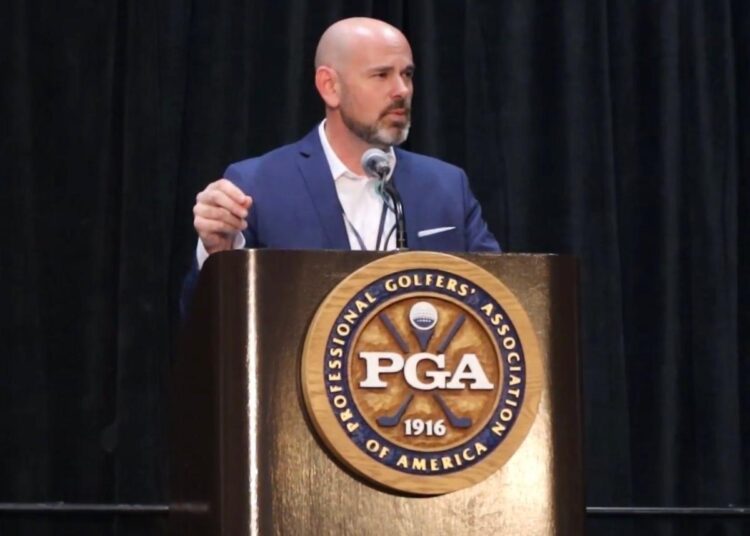Jay Karen is beginning his 10th year as the CEO of the National Golf Course Owners of America and 29th year in association management and he continues to preach that the bedrock of the golf industry is the golf course owner. Ahead of hosting the NGCOA’s annual golf business conference during the PGA Show, Karen took time to answer 10 burning questions we had for him on the state of the game heading into 2025.
GWK: We’re at the PGA Show this week with 30,000 foot soldiers for the game, many of whom take their marching instructions from your members. Given that your owners have influence over the type of programs it performs and as much skin in the game as anyone, how would you and your members like to see the PGA of America evolve in the coming years?
JK: NGCOA and the PGA of America are close allies and partners, collaborating on advocacy at the federal, state and local levels, and programs like this very show. Lately, there has been momentum to get golf professionals out from behind the counter to spend more direct time with golfers and customers, and I’m here for it. Getting more people playing and loving the game is probably the best thing PGA members can do for the business. My wish list for the PGA would include more robust programming and education around adult activation and deep engagement at the course level. Also, it would be wonderful to see the PGA Junior League program offered through parks and recreation offices around America, where kids also enroll in baseball, basketball, football, soccer, etc. I could see that program being as ubiquitous as any other youth sport.
GWK: What’s one thing you wish more people understood about the NGCOA?
JK: While we are indeed an association for golf course owners, NGCOA serves and includes anyone or any entity that operates a golf course of any kind, including daily fee facilities, resorts, private clubs and municipalities. We welcome any course operator who cares about the health and success of their business and this industry.
2025 PGA Merchandise Show: live updates and highlights from the biggest golf event of the year
GWK: What’s one decision from 2024 pertaining to work you’re especially proud of?
JK: We launched our Champions Circle program to help fund various legal and advocacy initiatives, including recent victories for golf courses that were subject to threatening lawsuits in Massachusetts and New York. Many generous NGCOA members and corporate partners stepped up to ensure our work is financially sustainable. Through the Champions Circle program, we also recognized important members in Congress who are helping to advance our agenda. We are making a difference.
GWK: What is one grassroots program in the industry that you see making a significant difference?
JK: Honestly, the biggest difference-makers at the grassroots level are those independent, boot-strapped programs that have been welcoming and serving a wide range of golfers for many years – some for decades – without much involvement or support from the national bodies. I’m talking about Latina Golfers Association, Black Girls Golf, Midnight Golf Program, Ted Rhodes Foundation, Women of Color Golf and the myriad of adaptive golf programs for those with mobility, sensory, cognitive or neurological impairments. The above list only scratches the surface, and because of the Make Golf Your Thing program started by the USGA, PGA Tour, PGA of America and LPGA, more funding has been making its way to those doing some heavy lifting. Giving oxygen to grassroots programs is often better than creating new top-down programs.
GWK: The online tee time space is ever-evolving. What are the pros and cons of the latest developments?
JK: I’ve seen more exuberance from the tech sector in the past few years than I’ve seen in a good while, and it’s exciting. Much of it seems to stem from the enormous increase in demand for golf. We now see waitlist technology to help match golfers with newly-available tee times, and secondary-market platforms that allow golfers to resell tee times, much like what Stubhub does for ticketed events. These can be additive to the golf economy, if they are helping golf courses truly grow their businesses and create stronger bonds with their customers. What we don’t need – and we’ve seen this happen – are tech companies simply trying to take a slice out of the golf economy without solving real problems for golf courses or driving incremental demand. When technology simply shifts existing demand and booking behavior away from the course, golf courses may not win economically. If courses don’t win economically, they can’t serve the game and the customers in the best possible ways.
GWK: Why do you see municipal golf’s role in the future of green-grass golf as being critical?
JK: Over the past 20 years, most course closures in America have been privately owned, public facilities on the low green fee side of the bell curve. Not all of these closures are failure stories, but often redevelopment projects. Transitioning to new land uses have been economic wins for those families and individuals who built and ran golf courses for decades. As my friend Dr. Joe Beditz from the NGF used to say, the dirt was worth more than the turf. If you carry the golf course supply trend line out another fifty or a hundred years, it’s easy to predict that affordable, daily fee courses near population centers will continue to be ripe for the picking by developers. It’s not an existential crisis for golf, but would mean a shift in supply. If demand stays strong and public golf supply shrinks, the nation’s nearly 3,000 municipal golf courses may become even more important in serving the public golfer. For much of the 20th century, municipal golf was the primary supply of public golf in America, and it’s in their DNA to keep those spaces green. They are our past and will be part of our future.
GWK: From automated clubhouse answering services to maintenance crews comprised of unmanned robots, how is AI shaking up the industry?
JK: Both AI and automation show serious promise in the golf operations space. If these new resources allow course operators to improve their margins, and simultaneously redeploy staff in more meaningful ways, it will be a win. Imagine golfers using self check-in kiosks, streamlining their way to the practice area or first tee. Imagine food and beverage being delivered to you out on the course, on demand. And maybe even delivered by drones! Having rules interpretations, swing feedback and other “big data” in your hands as a golfer in lightning-fast apps. These developments are happening now, and I’m anxious to see what else is coming.
GWK: Affordability is a recurring theme in the golf industry. Owners certainly want to fill a tee sheet, but also drive maximum revenue. Where do you see prices headed?
JK: This question underscores the tension between making sure golf is economically accessible to the masses, but also ensuring robust enough financials at the facility level to do everything a course owner must. This includes keeping staff paid well, ensuring all infrastructure is in good shape, improving amenities, paying for new technology, etc. One way courses walk that tightrope is to employ dynamic pricing strategies, so tee time pricing may fluctuate several times per day. Rare is the course that achieves 90% occupancy on their tee sheet, so there is still room at most courses to accommodate special programs aimed at welcoming people not ready or able to pay a strong fee. But the industry experienced our own recession for fifteen years, and not being able to increase prices put courses behind the eight ball. It would be nice to never see that movie again.
GWK: What is the biggest challenge facing the NGCOA in 2025 that we haven’t touched on yet?
JK: The biggest challenge we have at NGCOA is one we created for ourselves: to grow our membership from 4,000 to 5,000 courses. Associations rely on the strength of their membership to make everything else work: from advocacy effectiveness to event participation, from crowd-sourcing problems to test-driving new concepts, and from collecting and reporting data to driving value for our sponsors and partners. We have been on a growth curve for a number of years, and we are attempting to accelerate it.
GWK: What’s the hill you are willing to die on in 2025?
JK: As long as I’m at NGCOA, I will continue to preach the importance of course operators maintaining total control of their pricing and customer relationships, and not yielding too much power to disintermediaries. Many courses barter their tee times with online tee time agencies for marketing and other services, and give those agencies control over tee time pricing and customer engagement, to the detriment of the golf economy, in my opinion. I’m working closely with Google, as a new channel to deliver tee time seekers directly to golf courses. We are making good progress. I will die on the hill of ensuring courses are not taken advantage of and have the healthiest possible relationships with service providers in our industry.
This article originally appeared on Golfweek: NGCOA’s Jay Karen tackles the big questions addressing the golf world
Read the full article here



























Discussion about this post